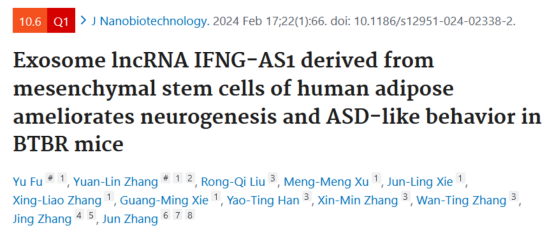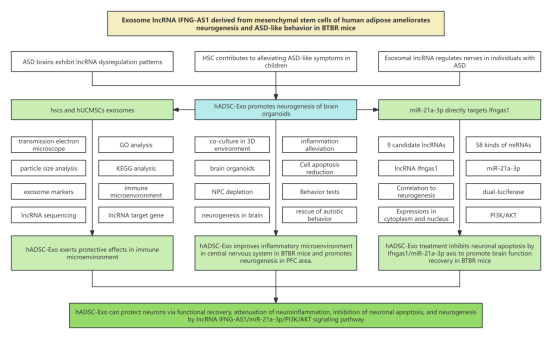Please click the button below to go to our email login page
|
A strong combination of “exosome + autism” has been published in Q1 with an IF of 10.6. Jun Zhang’s team from Tongji University reveals the potential therapeutic route to autismExosomes are extracellular vesicles produced by cells, carrying nucleic acid, proteins, lipids and metabolites. These vesicles, as mediators of near-distance and long-distance cell-to-cell communication in healthy and diseased states, impact cell biology from different aspects. Then, what are project design ideas about exosomes? Today, let’s discuss it together.
Today, we will share a paper published on Journal of Nanobiotechnology from Q1 of Chinese Academy of Sciences, with an IF of 10.6, hoping to bring different inspirations.
1. Research background 1.1 Exosomes contain lncRNA, playing key roles in the regulation of neurogenesis in individuals with autism spectrum disorders (ASD); 1.2 Most ASD patients displays common lncRNA dysregulation patterns, such as PTCHD1AS 1-3, SHANK2-AS and BDNF-AS in brain. 1.3 ASD has core symptoms including social disorder, communication disorder and repetitive behavior disorder, which is a heterogeneous developmental disorder. 1.4 Recent research indicated that transplantation of hematopoietic stem cells (HSCs) from fetal liver can help alleviate ASD like symptoms in children.
2. Technical route
3. Research results 3.1 Characterization of extracellular vesicles derived from hADSC and hUCMSC 3.2 LncRNAs sequencing analyses verified hADSC-Exo and hUCMSC-Exo 3.3 hADSC-Exo suppresses neural stem cell (NSC) proliferation, and tends to promote neurogenesis in brain organoids 3.4 hADSC-Exo can mediate neurogenesis and brain inflammation-related gene expressions in BTBR mice 3.5 hADSC-Exo treatment can alleviate inflammation and boost neurogenesis in PFC area of BTBR mice 3.6 hADSC-Exo can reverse ASD-like behaviors in BTBR mice 3.7 In hADSC-Exo, lncRNA IFNGAS1 has been demonstrated to be markedly related to ASD 3.8 Ifngas1 can act as molecular sponge of miR-21a-3p and thus negatively regulate AKT signaling pathway
4. Conclusion This article proved hADSC-Exos can protect neurons by restoring functions, attenuating neuroinflammation, inhibiting neuron apoptosis, and promoting neurogenesis in vivo and in vitro. hADSC-Exos-derived lncRNA IFNG-AS1, as molecular sponge, boosts neurogenesis through miR-21a-3p/PI3K/AKT signaling pathway, thereby playing regulatory roles. This discovery provides a potential treatment approach for autism patients. |


